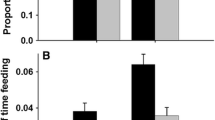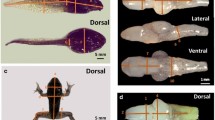Abstract
Anuran larvae exhibit high levels of phenotypic plasticity in growth and developmental rates in response to variation in temperature and food availability. We tested the hypothesis that alteration of developmental pathways during the aquatic larval stage should affect the postmetamorphic performance of the Iberian painted frog (Discoglossus galganoi). We exposed tadpoles to different temperatures and food types (animal- vs. plant-based diets) to induce variation in the length of the larval period and body size at metamorphosis. In this species, larval period varied with temperature but was unaffected by diet composition. In contrast, size at metamorphosis was shaped by the interaction between food quality and temperature; tadpoles fed on an animal-based diet became bulkier metamorphs than those fed on plant-based food at high (22°C) but not at low (12°C) temperature. Body condition of newly metamorphosed frogs was unrelated to the temperature or food type experienced during the premetamorphic stage. Frogs maintained at high temperature during the larval period showed reduced jum** ability, especially when fed on the plant-based diet. However, when considering size-independent jum** ability, cold-reared individuals exhibited the lowest performance, and herbivores reared at 17°C the highest. Cold-reared (12°C) frogs accumulated larger amounts of energy reserves than individuals raised at 17°C or 22°C. This was still the case after correction for differences in body mass, thus indicating some size-independent effect of developmental temperature. Despite the higher lipid content of the carnivorous diet, the differences in energy reserves between herbivores and carnivores were relatively weak and associated with differences in body size. These results suggest that the consequences of environmental variation in the larval habitat can extend to the terrestrial phase and influence juvenile growth and survival.
Similar content being viewed by others
Author information
Authors and Affiliations
Corresponding author
Additional information
Electronic Publication
Rights and permissions
About this article
Cite this article
Álvarez, D., Nicieza, A.G. Effects of induced variation in anuran larval development on postmetamorphic energy reserves and locomotion. Oecologia 131, 186–195 (2002). https://doi.org/10.1007/s00442-002-0876-x
Received:
Accepted:
Published:
Issue Date:
DOI: https://doi.org/10.1007/s00442-002-0876-x




